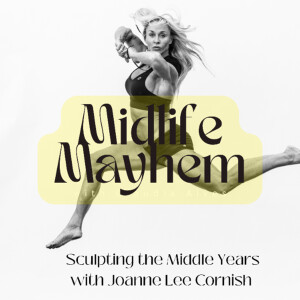
Monday Mar 10, 2025
MIDLIFE CHOLESTEROL
In this episode of Midlife Mayhem, we’re diving deep into a topic that causes a lot of unnecessary stress—cholesterol. Especially in midlife, those blood test results can feel overwhelming. Your doctor might throw around terms like “high LDL” or “you need a statin,” and suddenly you’re spiraling down a rabbit hole of confusion and concern.
Let’s break it all down.
We start by explaining the basic cholesterol markers you’ll typically see on your lab work:
- Total Cholesterol – This is the sum of all cholesterol in your blood. But spoiler alert—it’s not the most helpful number on its own.
- HDL (High-Density Lipoprotein) – The "good" cholesterol. It helps remove excess cholesterol from your bloodstream and take it back to your liver.
- LDL (Low-Density Lipoprotein) – The so-called "bad" cholesterol. This one gets a bad reputation because, in high amounts, it can contribute to plaque buildup in your arteries.
- Triglycerides – These are fats found in the blood and are heavily influenced by your diet and lifestyle. High triglycerides can increase your risk of heart disease.
- VLDL (Very-Low-Density Lipoprotein) – Less commonly mentioned, but closely tied to triglyceride levels.
- LDL/HDL Ratio – A calculation that compares your total cholesterol to HDL. Ideally, this number should be below 3.5.
Here’s what’s really important to understand: Total cholesterol doesn’t tell the whole story. If you have high HDL (a good thing) and low triglycerides (another good thing), your total cholesterol number might look high, but that doesn’t automatically mean you’re at risk. It’s like looking at someone’s weight without knowing their muscle mass—it lacks context.
So, what should you be aiming for?
We want high HDL, low LDL, and low triglycerides. When those three are in the right range, the rest often follows. But things get interesting (and more complex) in midlife, especially for women.
As estrogen declines during perimenopause and menopause, LDL levels often rise. Even if you haven’t changed your diet or routine, your numbers can shift simply due to hormonal changes. HDL might dip. Triglycerides might increase, especially if you’re becoming more insulin resistant. So no, you’re not doing anything wrong—this is just part of the hormonal rollercoaster.
And that’s where the standard blood panel can fall short. If your doctor flags your total cholesterol or LDL and starts talking statins, know this: they’re required by guidelines to suggest statins when certain numbers are flagged. That doesn’t mean you need to fill the prescription immediately—but it does mean it’s time to dig deeper.
This is your cue to ask for advanced cholesterol testing.
Here’s what to request:
- ApoB (Apolipoprotein B): This tells you the number of LDL particles, not just how much cholesterol is in them. It’s a better predictor of cardiovascular risk.
- Lp(a) [Lipoprotein (a)]: A genetically influenced cholesterol marker that’s sticky and more likely to cause plaque buildup. It’s not routinely tested, but it should be if you have a family history of heart disease.
- Calcium Scan (Coronary Artery Calcium Score): This is a CT scan that shows if you have actual plaque in your arteries. You can have high cholesterol and zero plaque—or normal cholesterol and dangerous buildup. The scan doesn’t lie.
If heart disease runs in your family, you need to be the one asking for these tests. Standard labs won’t tell you everything, and early intervention depends on getting the full picture.
And while we’re clearing things up—high LDL is not an emergency on its own. If the rest of your numbers are solid—high HDL, low triglycerides, low inflammation—then high LDL might not be cause for panic. This is especially true for midlife women who are otherwise healthy and active.
But—and this is key—family history matters. If your parent or sibling had a heart attack in their 40s or 50s, take it seriously. Combine your blood work with advanced testing and imaging. Don’t rely on surface-level numbers.
We also cover what you can do naturally to support healthy cholesterol levels:
To lower LDL:
- Increase soluble fiber (oats, chia seeds, flaxseed, psyllium husk)
- Focus on healthy fats (olive oil, avocado)
- Reduce processed food
- Consider supplements like berberine or red yeast rice (always check with your doc first)
To raise HDL:
- Regular exercise, especially strength training and interval work
- Add omega-3s (fatty fish, flax, walnuts)
- Niacin, in some cases (not for everyone)
To lower triglycerides:
- Cut back on sugar and refined carbs
- Prioritize protein and healthy fats
- Avoid sugary drinks and alcohol
To reduce inflammation:
- Load up on anti-inflammatory foods (berries, leafy greens, turmeric)
- Manage stress and sleep
- Move your body daily
Lastly—don’t forget the basics when it comes to lab accuracy.
Get your blood drawn in a fasted state (8–12 hours), and be well hydrated. Dehydration or a non-fasted state can spike your triglycerides and give you a completely misleading result.
So don’t let a “high cholesterol” label scare you into blindly following the standard path. Understand your numbers, ask better questions, and look at the whole picture.
If you found this episode helpful, please share it with a friend who’s staring at their lab results in total panic. And if you’re ready to take real control of your health in midlife, come find me—I’d love to help you build the body and confidence you deserve.
Last Call! Muscle Month starts this Sunday - for podcast listeners who made it to the end of the show notes:) Use discount code MUSCLE for a 25% ($120) discount at www.musclemonth.com
Want more?
Connect with me:
🌐 Website: www.theshrinkshop.com
📱 Instagram: @joanneleecornish
No comments yet. Be the first to say something!